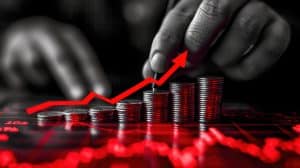US inflation CPI 2.7%: what it means for you


CPI inflation 2.7 percent may sound like a technical snapshot, but it reflects real movement in the price of everyday goods. When the cost of living shifts, households feel it, from groceries to transportation.
Understanding this environment helps you respond financially with confidence.
This rise signals a moderate but notable trend that highlights changing consumer behavior, evolving market pressures, and the need to reassess budgeting strategies.
Understanding CPI inflation
Understanding CPI inflation is crucial for grasping how prices change over time. The Consumer Price Index (CPI) measures the average change in prices paid by consumers for goods and services.
It’s an essential tool used by economists to assess inflation and its impact on the economy.
The key components of the CPI include various categories such as food, housing, and transportation. These categories reflect what people typically buy. Changes in these prices can indicate broader economic trends.
Components of CPI
The CPI includes several categories that play a vital role in calculating inflation. Here are the main components:
- Food and beverages: Includes groceries and dining out.
- Housing: Covers rent, costs of owning a home, and utilities.
- Transportation: Encompasses vehicle costs, public transport, and fuel.
- Medical care: Includes healthcare services and medications.
Tracking CPI inflation helps consumers understand how their purchasing power may change. If CPI inflation rises, a dollar buys less than before, affecting savings and spending habits.
For example, if prices increase by 2.7%, you might feel the pinch at the grocery store or when filling up your gas tank.
How CPI Inflation Affects You
The rise or fall of CPI inflation directly impacts everyday spending. For instance, when inflation is high, you might notice it in your monthly bills and the cost of goods.
This can lead to adjustments in your budget as you seek to control your expenses.
Conversely, low inflation can benefit consumers, as prices remain stable. People can plan their finances better, knowing that their money retains its value.
It’s essential to keep an eye on trends in CPI inflation because they signal how the economy is doing overall.
Factors influencing CPI inflation
Many factors influence CPI inflation, and understanding them can help you grasp price changes better. Key elements include supply and demand, production costs, and government policies that all play a role in shaping the economy.
Supply and demand directly impact inflation levels. When demand for goods increases, prices often rise as businesses try to keep up with demand.
Additionally, if supply drops due to circumstances like natural disasters or supply chain issues, prices may also increase.
Production Costs
Another significant factor is production costs. When the cost of labor or materials increases, companies may pass those costs onto consumers. This can lead to higher prices, affecting the overall CPI inflation rate.
- Rise in wages: Higher wages mean more spending power, which can increase demand.
- Raw material costs: If materials become more expensive, prices of finished goods will typically rise.
- Energy prices: Fluctuations in energy costs can greatly influence production expenses.
Government policies also play a role in inflation. Central banks control interest rates, which can influence spending and saving habits.
For example, if interest rates are low, borrowing is cheaper, which can lead to increased spending and potentially higher inflation.
Conversely, high-interest rates tend to slow down spending, which can keep prices stable. Understanding these connections can illuminate why CPI inflation may fluctuate.
Impact of 2.7 percent inflation on the economy

The impact of 2.7 percent inflation on the economy can be significant, affecting both consumers and businesses. This level of inflation can influence purchasing power, spending habits, and overall economic growth.
When inflation hits 2.7 percent, consumers may notice that their money does not stretch as far as it used to. This can lead to changes in buying habits, where people might prioritize essential items over luxury purchases.
A slight increase in prices often leads to increased caution among consumers regarding their expenditures.
Effects on Consumer Behavior
At a rate of 2.7 percent inflation, people might start re-evaluating their budgets. For example, they may:
- Reduce spending: Buying fewer non-essential goods or delaying purchases.
- Seek discounts: Actively looking for sales, promotions, or cheaper alternatives.
- Adjust saving habits: Trying to save more money to buffer against rising prices.
This cautious behavior can contribute to slower economic growth as businesses may see reduced sales. Concurrently, companies might adjust their pricing strategies to keep up with inflation, possibly leading to further increases in prices.
Impact on Wages and Employment
The labor market can also react to inflation rates. Employers might face pressure to raise wages to attract and retain employees.
If wages rise, it can help workers maintain their purchasing power but may also lead to increased operational costs for businesses.
With 2.7 percent inflation, it is essential to monitor wage growth. If wages do not keep up with inflation, real income declines, and consumers cannot buy as much as before, straining overall economic activity.
Strategies to cope with rising inflation
As prices rise, finding effective strategies to cope with inflation becomes vital. Educating yourself about how to manage your finances can help you navigate the challenges posed by rising costs.
Having a clear plan can ease the stress that often accompanies inflation.
One way to cope with rising inflation is by adjusting your budget. Analyze your monthly expenses and identify areas where you can cut back.
This allows you to allocate more funds to essential items. For instance, you might reduce dining out or subscription services to save money.
Investing Wisely
Investing can also protect your wealth from inflation. Consider assets that typically keep pace with or exceed inflation, such as:
- Real estate: Property values often rise, making real estate a solid long-term investment.
- Stocks: Certain stocks can provide returns that outpace inflation.
- Inflation-linked bonds: These bonds adjust their interest payments based on inflation rates.
By investing in these areas, you can not only preserve your capital but also potentially grow it over time. Understanding the right investment mix based on your risk tolerance is essential for navigating inflation successfully.
Increasing Your Income
Another strategy is to look for ways to increase your income. This could include asking for a raise at work, starting a side job, or exploring freelance opportunities.
Increasing your earnings can help offset the impacts of inflation on your daily life.
Continually developing your skills can also lead to better job prospects and higher wages. Participation in workshops or online courses can enhance your employability, making it easier to secure raises or promotions.
Remember, boosting your income is a powerful way to combat rising prices.
Future trends in CPI inflation

Understanding future trends in CPI inflation is essential for preparing your financial strategies. Economists use various indicators to predict how inflation might behave over the coming years.
These trends can help individuals and businesses make informed decisions.
One significant factor influencing future CPI inflation is monetary policy. Central banks, such as the Federal Reserve in the United States, adjust interest rates based on inflation levels.
When rates are low, borrowing is cheaper, which can lead to increased spending and, potentially, higher inflation. Conversely, higher rates can cool off spending but may slow down economic growth.
Supply Chain Dynamics
The state of global supply chains is another critical aspect affecting inflation. Recent disruptions caused by events like the pandemic have made industries more cautious. Companies are now focusing on building more resilient supply chains.
If supply remains constrained while demand increases, prices may rise further.
- Geopolitical tensions: Conflicts can disrupt trade and increase costs.
- Natural disasters: Events that affect production can lead to shortages and higher prices.
- Technological advancements: Improvements in production efficiencies may help manage costs.
Additionally, consumer behavior plays a role in shaping future inflation. As people adapt to changing economic conditions, their spending habits may reflect their expectations of future prices.
If consumers anticipate higher prices, they may rush to make purchases, further fueling inflation.
Government Policies
Government policies also contribute to future trends in CPI inflation. Fiscal measures, such as stimulus packages, can stimulate demand. However, if too much money floods the economy, it may lead to inflationary pressures.
Policymakers need to find a balance to avoid stoking inflation while supporting economic growth.
Overall, keeping an eye on these trends can provide valuable insights into how CPI inflation might evolve. Being proactive and adapting financial strategies accordingly can help individuals navigate the complex landscape of inflation.
Conclusion
The rise of CPI inflation 2.7 percent underscores how quickly costs can shift and influence your finances. While moderate, this change requires thoughtful planning, from budgeting to investing, to ensure continued financial stability.
Recent data from the U.S. Bureau of Labor Statistics confirms a 2.7% year-over-year CPI increase ending June 2025, driven largely by shelter and services pricing.
Understanding these trends helps consumers anticipate challenges and act early.
For further insight, you can review the official CPI report here:
🔗 https://www.bls.gov/opub/ted/2025/consumer-price-index-rose-2-7-percent-for-the-12-months-ending-june-2025.htm
Staying informed empowers smarter decisions — helping protect your purchasing power in a shifting economy.
FAQ – Understanding CPI Inflation and Its Impact
What does CPI in CPI inflation stand for?
CPI stands for Consumer Price Index, which measures the average change in prices paid by consumers for goods and services.
How does rising inflation affect my everyday expenses?
Rising inflation means that the purchasing power of your money decreases, causing prices of groceries, gas, and other necessities to increase.
What can I do to protect my finances during inflation?
To protect your finances, consider budgeting wisely, investing in inflation-protected assets, and exploring ways to increase your income.
Is inflation a sign of a healthy economy?
A moderate level of inflation can indicate a growing economy, but high inflation can signal economic instability and can hurt consumers.
Liked the article?





